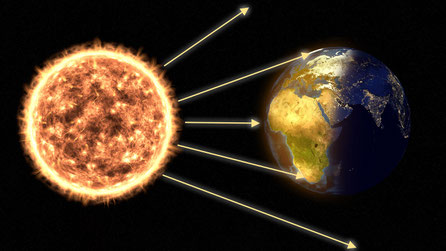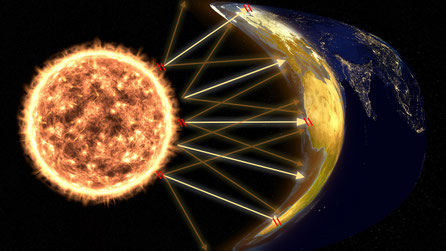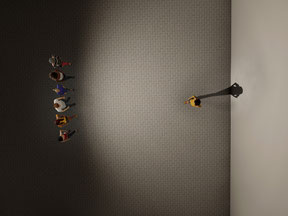So, last time we likened light to water without the gravitational pull. This time, we ask ourselves how different shadows come about. Why are they sometimes harsh and sometimes nearly indistinguishable from the background?
I’m sure you have noticed the lack of a shadow on a cloudy day or the appearance of one on a sunny day for those of you who come from countries prone to rain. But, as I’m sure you know, the sun isn’t gone, when it’s cloudy but instead just hidden behind them. Depending on the density of the cloud cover more or less illumination of the sun will reach the other side. So what does this mean? When it’s the same light, why do shadows then differ?
Well for me, usually one of these 3 scenarios are happening:
- Light comes from a long distance and thus becomes linear
- Light is diffused and reflected
- Light is bundled and directed
Linear Light due to distance
Imagine the sun being small enough to fit into your palm. The light it emits radiates out in all directions, so when does it become linear? It all depends on the size and distance to one another. But before I go into more detail, let me say the following. The sun actually is a scattering light source, which means, that the light from one point does not simply shoot out in one direction but instead funnels out in different directions. The bigger the object and closer the light source is to the object, the higher the chance for no shadow at all. The farther away the light source, the smaller the chance for stray light to reach you.
Let us start with a simple example not accounting for stray rays. When two objects are fairly close to one another and also have fairly the same size, the light that is emitted from the source will not all reach our object at the same angle and intensity, thus the lights intensity will be strongest at the closest point to one another and weaker the stronger the curvature of the light source and the object in question.
If the object would curve parallel alongside the light source, the intensity of the light would be the same at all points of contact, as you can see here. Accounting for stray rays one can assume rather soft shadows as rays would not only hit a person standing on the surface from the front but also from the sides.
If the light source in question is extremely big and close to the object, the possibility is high, that the surface of the light source illuminating the object is flat and thus distributing light equally to the object only losing in intensity caused by the curvature of the object. We can also presume the same result as before concerning the soft shadows in this scenario as we did before.
This last version shows what is happening on Earth. The sun is a large object compared to the dimensions of the Earth, and the distances are even vaster than depicted here. As only a small portion of the suns light rays point directly towards the Earth, we are hit almost linearly with the rays. The rest is lost to the universe around us. As hardly any stray rays point exactly in our direction we are treated to rather harsh shadows on a sunny day.
Imagine standing in front of a wall, facing a mob of people throwing paint balls straight ahead. Balls splatter all around you and when you turn around a perfect outline of a human body can be seen. This outline is your shadow.
Diffused Light
So what does diffused light look like? Diffused light can be likened to the 3. Example from before, where the light source was immense and surrounding the object in question. As we aren’t burning up there must be something else happening. Diffused light is also created our very own clouds as well as brightly coloured and light-permeable substances and fabrics such as white sheets. Let’s imagine a cloudy day, not heavily clouded as happening during a rain storm, but the bright clouds that hurt your eyes when looking at them and making you wear sunglasses and looking kind of funny doing so. The clouds act like a giant brightener. Each point on the clouds, that is hit by a sunray, becomes a small new light source, which then scatters the light in all directions. The result is a low contrast atmosphere with soft to no shadows.
Let’s return to the example from earlies. This time, the mob of people are not only throwing balls straight ahead but also to their left and right. When you turn around once more the outline is not as pronounced as it was before. That happened, because you weren’t only hit straight on but also from the sides.
Bundled Light
Bundled light can either be a scattered light being directed by means of fex. shading or barn doors as used with stage lights or compressed into a certain direction using lenses as happening with lasers. Those light sources are either, in the case of a laser, not suitable for actual illumination due to its light compression or, in case of stage lights, are used to illuminate an object over a greater distance without losing its intensity by scattering.
Watch the video about
"Mastering light and shadwos in your photographs –
How light behaves Part 2|2"











